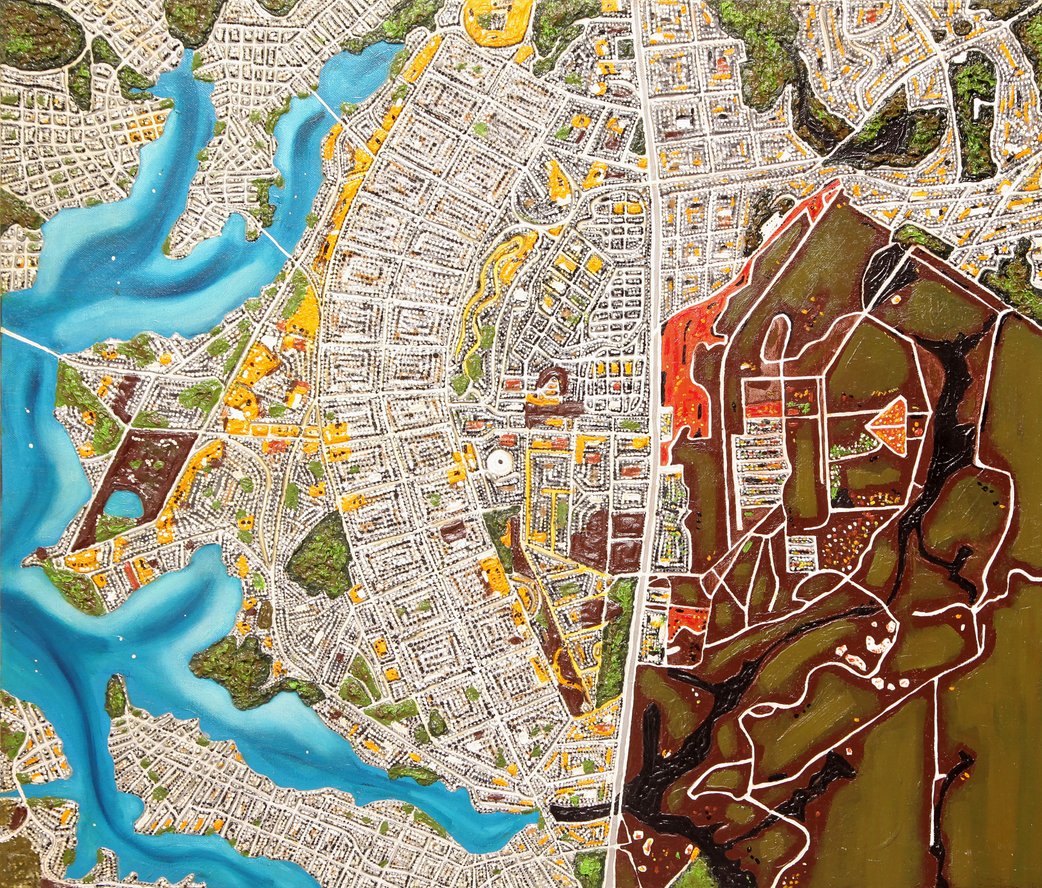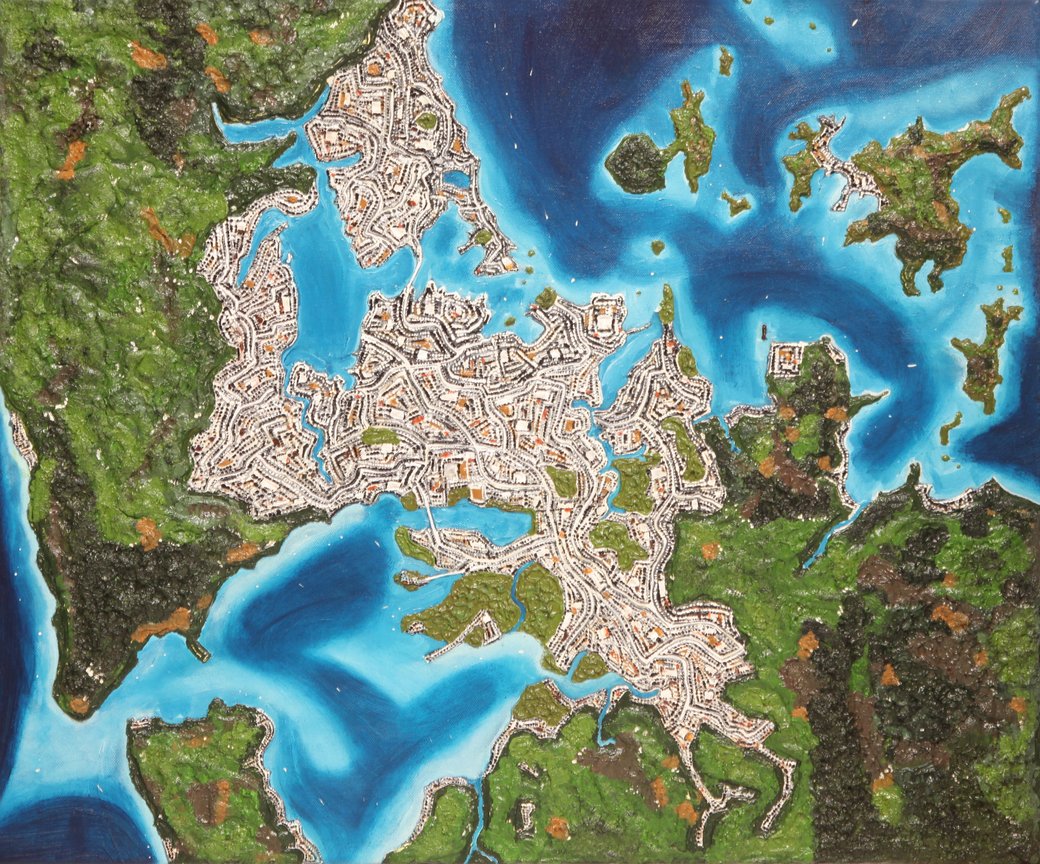Francesco FISCARDI
The anatomy of the metropolises, the innovative space perspective
in the latest collection of Francesco Fiscardi
With the new collection The anatomy of the metropolises, Francesco Fiscardi brings to conclusion a skilful historical-artistic operation proposing again the perspective from above, which has its chronological precedent in the bird’s eye views of Quattrocento memory, but adapting the depiction to the potentialities of the technological means of our contemporaneity, like drones and satellites, whose shots give us back completely new images of some among the largest cities of the earth. If in his known and valued series Metropolises of the world the Neapolitan artist sketched the great capitals through chromoformal synthesis structures, in this latest collection the colour supports a more figurative and detailed portrayal, however of absolute originality in the choice of the look-out point.
The topicality of Fiscardi’s intuition is in the transferring into the pictorial field an innovative view of the cities, already fashionable in the television and cinematographic field, with the resulting discovery of aspects completely unknown to most, like the precise urbanistic conformation of the different Metropolises, and that happens in a historical moment in which the space tourism begins to become reality through the first expeditions that involve not professional cosmonauts. From this the title The anatomy of the metropolises, that already outlines a new reading key of the depicted cities, of which the artist captures not only an overview, which this time reveals us completely surprising forms and colours, but it frames the metropolis itself in a wider landscape context of which Fiscardi lets us explore the peculiarities and that is, on the whole, a second level of portrayal more properly informal, almost completely autonomous with respect to the more sketched part of the work. The impression is that the figurative part of every painting is inscribed in the informal part in a stylistic mix in which the different sections of the work interacts in their tone-shaped diversities, as if it depicted the effect that the surroundings of a metropolis can have on the metropolis itself and vice versa.
Once again Fiscardi leads us in an imaginary itinerary through the five continents of the world, but it is a space travel now, the view is, together, virtual and symbolic, since the artist marries the observation and the concept; virtual, because the portrayal object couldn’t have been painted from life, but every work is the result of specific studies and of a deep sense of research that doesn’t split the detail from the entirety of the pictorial portrayal; it is symbolic, because it introduces the cosmic perspective as a new point of view arousing, also on this occasion, the fancy of the viewer that will be led to imagine how all the other corners of the world, and not necessarily the metropolises, must look from the same heavenly space. Here the operation of the Parthenopean painter oversteps the purely artistic bounds and flows into the philosophical: there isn’t an objective reality but only of perspective, and, in the coeval civilization, technology helps us to show it to us in its different facets.
On the executive plane, the stylistic subdivision reserves an informal treatment to the neighbourhood of the Metropolises, while the central nucleus is portrayed in the figurative way by minimal geometric structures, depicting the street network characterizing every capital, also pointing out their combinations with the natural elements like the watercourses that cross it, the parks which they are covered with, as well the hills by which they are dominated.
The overlook on the cities, to which the artist Francesco Fiscardi initiates us, opens therefore new pictorial settings, overtakes the traditional at grade portraying to show us its views from the cosmos able to illustrate us much more than a classic vedutistic foreshortening because the portrayal of the urbanistic structure, in its approaching with the surrounding landscape, can reveal us also the modus vivendi of a city community and its relation with the environment, and will also be able to turn to a historical-artistic witness of the present time in the forecast of a future development.
Prof. Domenico Raio
art critic
AFRICA
Cape Town - SOUTH AFRICA
oil and acrylic on canvas 60x70cm
Dakar - SENEGAL
oil and acrylic on canvas 60x70cm
Tunis - TUNISIA
oil and acrylic on canvas 60x70cm
AMERICA
Toronto - CANADA
oil and acrylic on canvas 60x70cm
New York City - U.S.A.
oil and acrylic on canvas 60x70cm
Brasilia - BRAZIL
oil and acrylic on canvas 60x70cm
ASIA
Hong Kong - CHINA
oil and acrylic on canvas 60x70cm
Riyadh - SAUDI ARABIA
oil and acrylic on canvas 60x70cm
Tokyo - JAPAN
oil and acrylic on canvas 60x70cm
EUROPE
Venice - ITALY
oil and acrylic on canvas 60x70cm
Stockholm - SWEDEN
oil and acrylic on canvas 60x70cm
London - ENGLAND
oil and acrylic on canvas 60x70cm
OCEANIA
Sydney - AUSTRALIA
oil and acrylic on canvas 60x70cm
Auckland - NEW ZEALAND
oil and acrylic on canvas 60x70cm
Numea - NEW CALEDONIA
oil and acrylic on canvas 60x70cm















